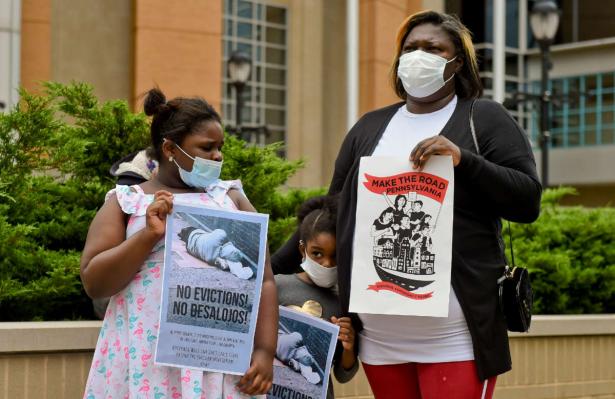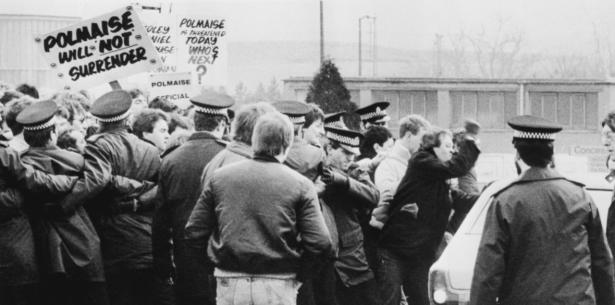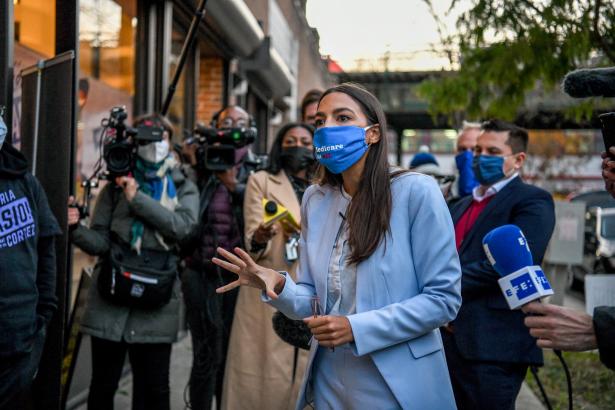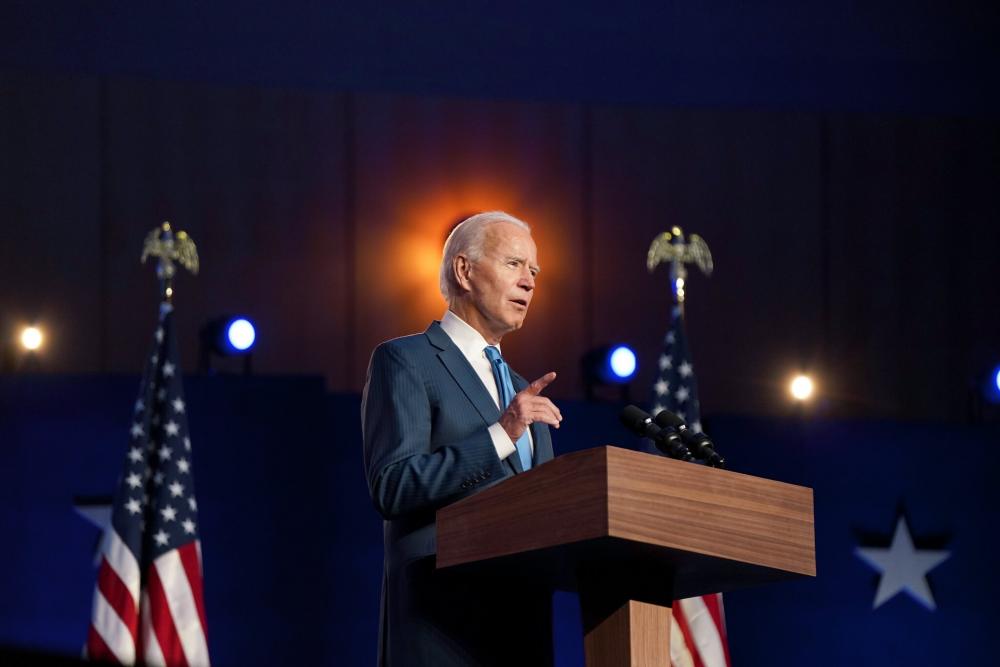Law enforcement organizations have long treated mass incarceration as a job creation program. In 2020, the tide began turning against them.
November 11, 2020 Jay Willis THE APPEAL

Law enforcement organizations have long treated mass incarceration as a job creation program. In 2020, the tide began turning against them.
This commentary is part of The Appeal’s collection of opinion and analysis.
Law enforcement unions are maybe the most powerful force in politics that most voters never think twice about. By quietly dumping millions of dollars in key prosecutor elections and ballot initiative fights, these organizations manage to affect everything in the criminal legal system’s orbit, usually while flying well beneath the political radar. Police unions are sort of like gravity, if gravity played a significant role in enabling agents of the state to systematically terrorize communities of color without facing meaningful consequences.
In races that take place outside the quadrennial spending bonanzas for control of the White House, these strategic allocations of time and outlays of resources can be decisive in elections, especially since no cohesive pro-reform interest group exists to counteract their influence. (Tight-knit, well-organized police unions can coordinate in ways that the larger but more heterogenous and dispersed coalition of people who favor criminal justice reform cannot.) One recent study found that law enforcement groups have spent about $87 million in local and state elections over the past 20 years, including almost $65 million in Los Angeles alone. At the federal level, their recent campaign contributions and lobbying expenditures approach $50 million, according to The Guardian.
Such expenditures are savvy investments for police unions, who keenly understand the value of having sympathetic friends in high places. Because prosecutors work so closely with police, they have a strong incentive to develop a friendly relationship with rank-and-file officers, even if earning that trust comes at the price of turning a blind eye to abuse: It is not a coincidence that researchers have tracked the rise of police unions to an increase in on-the-job police killings. In a country where law-and-order rhetoric is deeply embedded in the cultural zeitgeist, if you’re a prosecutor intent on keeping your job, filing charges against the badge-wearing hand that feeds might not feel worth the retaliatory smear campaign that will inevitably follow.
In recent years, however—and especially as a result of the sustained protests of police violence in the aftermath of George Floyd’s killing in Minneapolis—people have grown more attuned to how these organizations bend the criminal legal system to their will and stymie efforts to reform it. A growing number of elected officials have pledged to refuse the support of law enforcement organizations; in California, a coalition of reform-minded prosecutors has been lobbying for a state bar ethics rule that would prohibit DAs from accepting donations from these sources altogether, arguing that prosecutors cannot ethically prosecute police officers if they are receiving the support of their unions.
“The ties that bind elected officials to police unions must be broken,” the Los Angeles Times editorial board wrote in June. “An elected official considering whether to prosecute officers should not be, in essence, on the political payroll of the agency defending the very same people.”
On Election Day 2020 in California, voters delivered police unions a series of resounding defeats that threaten to flip this time-honored paradigm on its head.
In the race for Los Angeles County District Attorney, reform-oriented challenger George Gascón ousted incumbent Jackie Lacey, earning control of a sprawling office that employs nearly 1,000 line prosecutors and retains jurisdiction over more than 10 million people. Lacey was the clear favorite of law enforcement organizations, who spent some $5 million boosting her candidacy and attacking her opponent’s. And for good reason: During Lacey’s eight years on the job, she reviewed more than 250 fatal shootings by on-duty law enforcement officers. She filed charges in one of them.
Occasionally, Lacey’s penchant for lenience extended beyond even that of high-profile police officials. None other than then-LAPD chief Charlie Beck called on Lacey to charge one of his officers, Clifford Proctor, in the 2015 killing of Brendon Glenn, an unarmed, homeless Black man. Lacey declined. “As independent prosecutors, we’re supposed to look at the evidence and the law,” she said. “And that’s what we did.” When the time came for Lacey to seek re-election, it seems that grateful police unions did not forget her choice.
Gascón’s résumé is one that might seem as if it would appeal to law enforcement types: A former LAPD patrol officer who rose to the rank of assistant chief, he also served as police chief in San Francisco and Mesa, Arizona, and as district attorney in San Francisco, before returning to run for DA in the city where he grew up. But Gascón is among the group of prosecutors who have disclaimed the support of police unions, and his campaign pledges include reducing the population of the county’s chronically overcrowded jail system, reopening investigations of high-profile police shootings that Lacey had closed, and declining to seek the death penalty altogether. For the unions, loyalty apparently extends only so far as it will allow their members to evade accountability.
Their efforts echoed those of the San Francisco Police Officers Association during last year’s DA election, when it spent some $650,000 on, among other things, mailers that declared progressive DA candidate Chesa Boudin to be “the #1 choice of criminals and gang members.” These scaremongering predictions were insufficient to prevent the city’s voters from electing Boudin—also a member of the no-money-from-cop-unions coalition—as Gascón’s successor.
Further down the ballot in 2020, California voters rejected Proposition 20, which would have reclassified certain misdemeanor theft offenses as felonies and reduced the availability of parole. (Incidentally, this would have rolled back the reforms of Proposition 47, a successful 2014 referendum co-authored by Gascón.) In other words, Proposition 20 would have resulted in more incarceration for more people for longer periods of time, which is why law enforcement organizations contributed roughly $2 million to the campaign to pass it.
Police unions also opposed San Francisco’s Proposition E, which eliminated the city’s minimum police staffing requirement, and Los Angeles’s Measure J, which earmarked hundreds of millions of dollars in public resources for non-police community investment. The Los Angeles County Professional Peace Officers Association, which represents sheriff’s deputies, claimed that Measure J would “cripple public safety,” and local law enforcement organizations combined to spend more than $3.5 million fighting it. Both measures nonetheless passed with overwhelming support.
Law enforcement unions reliably oppose criminal justice reform for the simple reason that any attempts to reduce the criminal justice system’s footprint will make police less relevant. (Over the years, they have opposedeverything from body camera mandates to the simple requirement that officers wear nametags.) For them, mass incarceration is the world’s most lucrative job creation machine. To justify their lavish spending habits and the generous rules that apply to their conduct, police always frame themselves as a mere half-step ahead of staving off mass chaos, warning that any abrogation of their authority by naive do-gooders will put everyone in danger.
What this year’s election results demonstrate is that people understand the lies that infuse this narrative, which conspicuously omits from the ledger the staggering human costs that policing imposes on the communities it purports to keep safe. These losses won’t put an end to incidents of police brutality, or any other strain of rot that pervades the American criminal justice system. But they do signal that police unions are likelier to have to answer for their myriad failures, instead of relying on beneficiaries of their largesse to pretend that these failures do not exist.
Jay Willis is a senior contributor at The Appeal.
Local Unions Defy AFL-CIO in Push to Oust Police Unions
Several local unions have moved to oust police unions, despite the federation's approach that collective bargaining can be used for police reform.
June 30, 2020 Rebecca Rainey and Holly Otterbein POLTICO
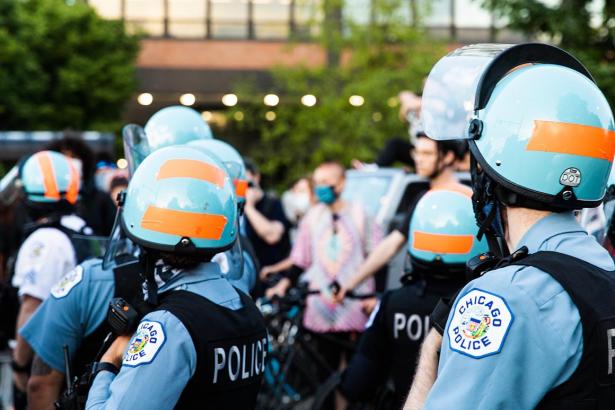
Chicago police officers face off with protesters.
The nation’s labor movement is splitting over police reform in the wake of George Floyd’s death.
Local unions are defying leaders of the AFL-CIO, who have rejected calls to cut ties with the labor federation's law enforcement arm and stressed the importance of collective bargaining instead to counter the use of excessive force. Several local unions, including those affiliated with the AFL-CIO, have moved to oust police unions within their locals and remove officers from schools and other workplaces. They argue that police have used their bargaining power to resist reform and protect those who have killed unarmed African Americans.
The vastly different approaches to solving what has become a major election year issue have not only exposed the rift within the labor movement but also threaten to diminish law enforcement unions in liberal cities and could even affect the behind-the-scenes race to succeed AFL-CIO President Richard Trumka.
“There are a lot of unions that are very concerned about police brutality,” said Lowell Peterson, executive director of Writers Guild of America-East, which adopted a resolution calling on the AFL-CIO to disassociate itself from the International Union of Police Associations, the federation’s police union affiliate. “There’s definitely a lot of talk in the labor movement about, ‘Why is this happening and what can we as unions do about it?’”
The nation’s second-largest teachers’ union, United Teachers Los Angeles, last week voted to eliminate police in Los Angeles public schools and “redirect funding to mental health and counseling” for students. The Chicago school board voted down a similar measure to cancel a $33 million contract with city police that was backed by the Chicago Teachers’ Union in protests and rallies throughout the week.
The Martin Luther King County Labor Council, a body of labor organizations representing more than 100,000 workers in the Seattle area, voted to expel the Seattle Police Officers Guild earlier this month. The Association of Flight Attendants, which sits on the AFL-CIO’s executive council, passed a resolution demanding that police unions embrace change “or be removed from the labor movement.”
Even the leader of the Service Employees International Union, the second largest union in the country, which itself represents some law enforcement employees, has expressed openness to the idea of ejecting police unions from the movement, though she has stopped short of endorsing the move.
“That's an option,” said SEIU President Mary Kay Henry of the Seattle federation’s decision to oust the police union. "I think another option is to use the union structure and leadership to educate and engage every member” in “re-imagining policing and criminal justice."
That would have been unheard of just months ago — and demonstrates how much has changed since Floyd’s death at the hands of a Minneapolis cop sparked nationwide protests against police brutality.
While labor activists say it is unlikely that Trumka would ever support efforts to expel law enforcement unions from the labor movement, the push from locals and some national unions to ostracize the police, as well as the larger Black Lives Matter movement, could drive more modest change.
Police unions have fought back, saying that no one forced local governments to sign collective bargaining agreements that contain provisions protecting police and warning that attacks on law enforcement unions are part of a pattern of going after organized labor.
“No contract is rammed down the throat of a city or jurisdiction. They signed it, they negotiated it, they agreed to it,” said Jim Pasco, executive director of the National Fraternal Order of Police.
Sam Cabral, the president of the International Union of Police Associations, slammed Trumka’s response to the unrest, writing in a June 12 letter that the federation's comments regarding America’s “history of racism and police violence against black people” were “inflammatory and patently false.” Cabral said he wouldn’t be willing to sit down with those who “have already indicted” law enforcement “based on one horrible incident.”
California’s largest police unions ran an ad in the Washington Post earlier this month calling for a national use of force standard, misconduct registry and “ongoing and frequent” training. Trumka also wrote in a recent op-ed that the labor movement is calling on Congress to adopt reforms including a chokehold ban and demilitarization.
Still, AFL-CIO leaders have maintained that the best way for the group to address the issue of police brutality is to “engage” its affiliates “rather than isolate them.”
Randi Weingarten, president of the American Federation of Teachers, an affiliate of the federation, said many members of the movement believe it’s important to have a conversation with police unions, “to the extent that they were willing to have it, for them to change and for us to change the criminal justice system.”
At the same time, the AFT recently passed a resolution calling to remove police from schools and instead train security personnel as “peace officers.”
Part of the solution, SEIU’s Henry suggested, is changing police collective bargaining practices.
“The role of the labor movement is to be a vehicle for the structural change that the Movement for Black Lives is demanding in policing and criminal justice all over this country,” she said.
Some progressives say those collective bargaining agreements often help shield officers accused of misconduct.
Dozens of city police departments, including in Minneapolis, have added provisions to their contracts that delay officer interrogations after suspected misconduct, according to a 2017 study. Agreements with police agencies in Austin, Baltimore, Chicago and Washington, D.C., have included language that mandated the removal of disciplinary records from personnel files over time.
As more local unions choose to step away or distance themselves from the police, the pressure to break with law enforcement unions has generated an internal debate over the issue within the AFL-CIO executive council itself in recent weeks.
Color of Change, a racial justice organization, said it has discussed the possibility of ejecting police unions with at least five labor groups in the AFL-CIO.
Weingarten said “a couple members of the council raised it” during a three-day meeting in June. In a call earlier this month, American Postal Workers Union leader Mark Dimondstein brought up the matter, according to a person on the line.
The federation’s general board released several recommendations on June 9 for affiliate unions to address police violence but declined to drop the International Union of Police Associations as requested by the WGAE.
The debate could affect the quiet race to succeed Trumka, who is expected to step aside. The election won’t be held until the federation’s convention in October 2021, but Flight Attendants union president Sara Nelson, whose organization has taken one of the most progressive stands on the question, and AFL-CIO secretary-treasurer Liz Shuler are both rumored to be interested in taking the role.
In June, Nelson publicly accused AFL-CIO leadership of misleadingly attributing a statement opposing the ouster of the IUPA to the entire general board.
“To be clear, this issue was not discussed by the General Board today and there was no vote on the resolution put forward by WGAE,” she tweeted. “Also, collective bargaining empowers workers; it is not a means to oppress workers’ rights.
Tim Schlittner, the AFL-CIO's communications director, disputed the claim. He said Trumka referred to the WGA-East’s resolution but that no one offered a motion on it.
The labor movement has successfully ousted unions in the past that didn’t abide by its principles. The Congress of Industrial Organizations expelled 11 member unions around 1950 due to their alleged links to the Community Party. The AFL-CIO also cut ties with three unions in 1957 over corrupt behavior. And throughout the Civil Rights movement in the 1950s and ’60s, the AFT moved to expel local unions that were racially segregated.
Police unions, meanwhile, insist that any efforts to oust them will blow back on all of labor.
“Those who are looking to kick police officers out of the union movement should be very careful," said Patrick Lynch, president of the Police Benevolent Association of New York. "The rhetoric that they are using now is the same rhetoric that has been used to strip union protections from teachers, bus drivers, nurses and other civil servants across this country."
Several local unions have moved to oust police unions, despite the federation's approach that collective bargaining can be used for police reform.
June 30, 2020 Rebecca Rainey and Holly Otterbein POLTICO

Chicago police officers face off with protesters.
Natasha Moustache/Getty Images
The nation’s labor movement is splitting over police reform in the wake of George Floyd’s death.
Local unions are defying leaders of the AFL-CIO, who have rejected calls to cut ties with the labor federation's law enforcement arm and stressed the importance of collective bargaining instead to counter the use of excessive force. Several local unions, including those affiliated with the AFL-CIO, have moved to oust police unions within their locals and remove officers from schools and other workplaces. They argue that police have used their bargaining power to resist reform and protect those who have killed unarmed African Americans.
The vastly different approaches to solving what has become a major election year issue have not only exposed the rift within the labor movement but also threaten to diminish law enforcement unions in liberal cities and could even affect the behind-the-scenes race to succeed AFL-CIO President Richard Trumka.
“There are a lot of unions that are very concerned about police brutality,” said Lowell Peterson, executive director of Writers Guild of America-East, which adopted a resolution calling on the AFL-CIO to disassociate itself from the International Union of Police Associations, the federation’s police union affiliate. “There’s definitely a lot of talk in the labor movement about, ‘Why is this happening and what can we as unions do about it?’”
The nation’s second-largest teachers’ union, United Teachers Los Angeles, last week voted to eliminate police in Los Angeles public schools and “redirect funding to mental health and counseling” for students. The Chicago school board voted down a similar measure to cancel a $33 million contract with city police that was backed by the Chicago Teachers’ Union in protests and rallies throughout the week.
The Martin Luther King County Labor Council, a body of labor organizations representing more than 100,000 workers in the Seattle area, voted to expel the Seattle Police Officers Guild earlier this month. The Association of Flight Attendants, which sits on the AFL-CIO’s executive council, passed a resolution demanding that police unions embrace change “or be removed from the labor movement.”
Even the leader of the Service Employees International Union, the second largest union in the country, which itself represents some law enforcement employees, has expressed openness to the idea of ejecting police unions from the movement, though she has stopped short of endorsing the move.
“That's an option,” said SEIU President Mary Kay Henry of the Seattle federation’s decision to oust the police union. "I think another option is to use the union structure and leadership to educate and engage every member” in “re-imagining policing and criminal justice."
That would have been unheard of just months ago — and demonstrates how much has changed since Floyd’s death at the hands of a Minneapolis cop sparked nationwide protests against police brutality.
While labor activists say it is unlikely that Trumka would ever support efforts to expel law enforcement unions from the labor movement, the push from locals and some national unions to ostracize the police, as well as the larger Black Lives Matter movement, could drive more modest change.
Police unions have fought back, saying that no one forced local governments to sign collective bargaining agreements that contain provisions protecting police and warning that attacks on law enforcement unions are part of a pattern of going after organized labor.
“No contract is rammed down the throat of a city or jurisdiction. They signed it, they negotiated it, they agreed to it,” said Jim Pasco, executive director of the National Fraternal Order of Police.
Sam Cabral, the president of the International Union of Police Associations, slammed Trumka’s response to the unrest, writing in a June 12 letter that the federation's comments regarding America’s “history of racism and police violence against black people” were “inflammatory and patently false.” Cabral said he wouldn’t be willing to sit down with those who “have already indicted” law enforcement “based on one horrible incident.”
California’s largest police unions ran an ad in the Washington Post earlier this month calling for a national use of force standard, misconduct registry and “ongoing and frequent” training. Trumka also wrote in a recent op-ed that the labor movement is calling on Congress to adopt reforms including a chokehold ban and demilitarization.
Still, AFL-CIO leaders have maintained that the best way for the group to address the issue of police brutality is to “engage” its affiliates “rather than isolate them.”
Randi Weingarten, president of the American Federation of Teachers, an affiliate of the federation, said many members of the movement believe it’s important to have a conversation with police unions, “to the extent that they were willing to have it, for them to change and for us to change the criminal justice system.”
At the same time, the AFT recently passed a resolution calling to remove police from schools and instead train security personnel as “peace officers.”
Part of the solution, SEIU’s Henry suggested, is changing police collective bargaining practices.
“The role of the labor movement is to be a vehicle for the structural change that the Movement for Black Lives is demanding in policing and criminal justice all over this country,” she said.
Some progressives say those collective bargaining agreements often help shield officers accused of misconduct.
Dozens of city police departments, including in Minneapolis, have added provisions to their contracts that delay officer interrogations after suspected misconduct, according to a 2017 study. Agreements with police agencies in Austin, Baltimore, Chicago and Washington, D.C., have included language that mandated the removal of disciplinary records from personnel files over time.
As more local unions choose to step away or distance themselves from the police, the pressure to break with law enforcement unions has generated an internal debate over the issue within the AFL-CIO executive council itself in recent weeks.
Color of Change, a racial justice organization, said it has discussed the possibility of ejecting police unions with at least five labor groups in the AFL-CIO.
Weingarten said “a couple members of the council raised it” during a three-day meeting in June. In a call earlier this month, American Postal Workers Union leader Mark Dimondstein brought up the matter, according to a person on the line.
The federation’s general board released several recommendations on June 9 for affiliate unions to address police violence but declined to drop the International Union of Police Associations as requested by the WGAE.
The debate could affect the quiet race to succeed Trumka, who is expected to step aside. The election won’t be held until the federation’s convention in October 2021, but Flight Attendants union president Sara Nelson, whose organization has taken one of the most progressive stands on the question, and AFL-CIO secretary-treasurer Liz Shuler are both rumored to be interested in taking the role.
In June, Nelson publicly accused AFL-CIO leadership of misleadingly attributing a statement opposing the ouster of the IUPA to the entire general board.
“To be clear, this issue was not discussed by the General Board today and there was no vote on the resolution put forward by WGAE,” she tweeted. “Also, collective bargaining empowers workers; it is not a means to oppress workers’ rights.
Tim Schlittner, the AFL-CIO's communications director, disputed the claim. He said Trumka referred to the WGA-East’s resolution but that no one offered a motion on it.
The labor movement has successfully ousted unions in the past that didn’t abide by its principles. The Congress of Industrial Organizations expelled 11 member unions around 1950 due to their alleged links to the Community Party. The AFL-CIO also cut ties with three unions in 1957 over corrupt behavior. And throughout the Civil Rights movement in the 1950s and ’60s, the AFT moved to expel local unions that were racially segregated.
Police unions, meanwhile, insist that any efforts to oust them will blow back on all of labor.
“Those who are looking to kick police officers out of the union movement should be very careful," said Patrick Lynch, president of the Police Benevolent Association of New York. "The rhetoric that they are using now is the same rhetoric that has been used to strip union protections from teachers, bus drivers, nurses and other civil servants across this country."
